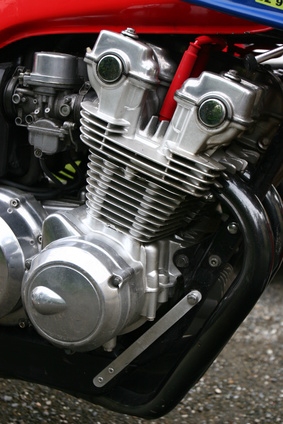
If you own a Honda VF750C motorcycle, it is vital that you check and adjust the way the carburetors sync to ensure top performance. Choose a dry, warm day to clean the carburetor if possible because this makes the process simpler and maintains the integrity of the individual components. The following instructions are for experienced home mechanics only. Novices should seek the help of a mechanic before attempting the project.
Remove the seat from the VF750C. Remove the gas tank. Remove the side panels and brackets using a crescent wrench and screwdriver. Remove the rubber intake valve cover. Slide out the air filter cover. Loosen and remove the intake housing plate. Rotate the intake horns. Do not allow the screws to fall inside the carburetors. Take all four carburetors off as one assembly.
Clean the carburetors carefully and maintain accurate synchronization between the carburetors to prevent motion instability at low gear and component wear and tear in the engine. Clean the jets using carburetor cleaning fluid. Remember: the jet needle has the greatest effect between 1/4 and 3/4 throttle, according to the Just KDX website.
Soak small engine parts in an old cup half filled with cleaning fluid for no more than 30 minutes. Spray the top edge of each carburetor with compressed air to remove fluids.
Replace dirty, damaged air filters with new ones. Replace blackened plugs with new plugs. Replace old gaskets with new, lightly-oiled gaskets. Refit the carburetor assembly carefully when fully cleaned. Coat the components in engine oil to protect and lubricate them. Wipe some oil onto the tubes. Remove excess oil using a dry cloth. Reconnect the fuel lines and accelerator cables and test the bike.
Check that the carburetors are running similarly in terms of the air-to-fuel ratio. Adjust the fuel mixture if necessary. Switch the engine back off for extra adjustments. Be sure to take into account atmospheric pressure at 15 pounds per square inch (PSI) during any adjustment.
Tighten or loosen the idle adjust screws to alter the mix at idle. Avoid too lean a fuel mix, because the engine will run too hot and cause damage to the components over time. You should also avoid too rich a mix because you will use too much fuel, which is expensive. If necessary, and with the help of a mechanic, change the diameter of the jets to adjust the mix at mid or full throttle.
Measure the cylinder temperature using an infrared heat gun. Aim to achieve cylinder temperatures within 15 degrees Celsius of one another, maximum. Any greater variation than this and the engine will not run smoothly.